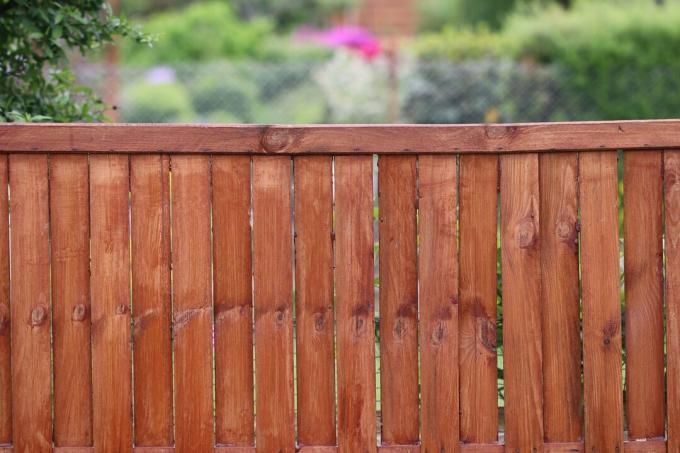
A fence or privacy screen in the garden can easily stir things up. They can quickly become a point of contention between neighbors. In the following, we will address the question of how high a fence between two properties can actually be.
In a nutshell
- there is no obligation to enclose
- Fence height regulated in Neighbor Law Act
- The amount varies from state to state
- Enclosure must be local
- Privacy fence up to 180 cm without approval
Table of contents
- Different types of enclosure
- Neighbor law regulates fence heights
- privacy fence
- frequently asked Questions
Different types of enclosure
In the jurisprudence, enclosure means the fencing of land. The fences will be there placed on or at the property line. They serve to shield the property from the outside to prevent unauthorized persons or animals from entering as well as to ward off wind, noise and road dirt and of course to differentiate from neighboring property. There are different types of enclosure:
- symbolic demarcation: 40 to 90 cm high
- for gardens and pastures: 100 to 140 cm high
- for privacy protection: 170 to 190/200 cm high
- Safety fences: from a height of 200 cm

Neighbor law regulates fence heights
How high an enclosure in the form of walls, hedges or fences to the neighboring property may be varies from state to state. The amounts are regulated in the respective neighboring law (NachbG) of the individual countries. However, the neighbor right is a private right. For example, certain regulations can be changed by regulations in the development plan of municipalities and cities. For example, many municipalities separately specify the customary height and type of fencing in their development plans or corresponding statutes. These regulations are then binding before the regulations in the Neighbor Law Act when building a fence. If it is impossible to determine that the enclosure is customary in the area, state law applies Regulations for use that are customary in the area with regard to the type and height of the fencing establish. This is how high a fence to the neighbor may be according to the neighbor rights laws of the individual federal states:
| Federal State | Allowed height | Legal basis |
|---|---|---|
| Berlin | 125 cm wire mesh | § 23 NachbG Bln |
| Brandenburg | 125 cm wire mesh | § 32 BbgNRG |
| Hesse | 120 cm wire mesh | § 15 NachbG HE |
| Lower Saxony | 120 cm high fence | § 28 NNachbG |
| North Rhine-Westphalia | 120 cm, wall or fence | § 35 NachbG NRW |
| Rhineland-Palatinate | 120 cm solid wire mesh | § 39 LNRG |
| Saarland | 120 cm solid wire mesh | § 43 NachbG SL |
| Saxony | local custom | §4 Saxon NRG |
| Saxony-Anhalt | 200 cm, customary for the area | § 23 NbG |
| Schleswig Holstein | 120 cm wire mesh | § 31 NachbG |
| Thuringia | 120 cm solid wire mesh | § 39 ThürNRG |

In the federal states
- Bavaria
- Bremen
- Hamburg
- Mecklenburg-Western Pomerania
there are no relevant legal regulations. Here the height and type of fencing are specified in the applicable building codes. When setting up an enclosure, no approval from the building authority is required if the relevant regulations are observed.
Tip: Talk to your neighbors before building the fence, and you should also obtain information from the local building authority about the existing regulations. Next to it is also one accurate determination of the property line necessary to ward off a deconstruction.
privacy fence
A privacy fence is intended to protect a property from the prying eyes of the neighbors. Here, too, the corresponding regulations are in the neighboring law acts of the federal states or in the can be found in the development plans of the cities and communities and here, too, is the local custom decisive. For privacy fences applies depending on the federal state
- Height between 170 and a maximum of 200 cm
- Distance to the property line maximum 50 cm

Depending on the federal state, the erection of a privacy fence at a height of 180 cm may not require a permit. Information on this can be obtained from the responsible building authorities.
Tip: If there is agreement, agreements can also be made with the neighbors that contradict the neighbors' law. However, they must then be recorded in writing in the event of a dispute.
frequently asked Questions
There will certainly be a dispute, which can also end up in court. If the fence is built too high and is so unusual for the location, the neighbor can, for example, demand that the fence be removed or reset to the permissible height. It is also possible to enforce the claim in court. However, deadlines must be observed. These vary by state. If the deadline has already expired, there is no longer any right to a change.
In order to assess the condition of a property enclosure, local custom is used in the individual neighboring law acts of the federal states. This means that the respective enclosure must be based on the local conditions. In other words, fencing must be more common within a given hamlet or settlement. If no customary locality can be determined, then state law regulations that determine the type and height of the enclosure apply.
In Germany, a property owner is not legally obliged to fence or fence his property. to put a fence to the neighboring property (BGB § 903). However, the neighbor can demand that a fence be put in place if the keeping of small animals such as chickens or dogs causes disadvantages or nuisance for his property. The type of fencing then depends on the impairment to be averted and the local custom.



